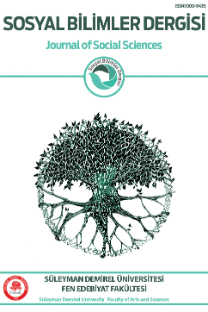Re- creating the doppelganger in peter ackroyd's the casebook of victor frankenstein
İngiliz çağdaş romancılarından Peter Ackroyd, Victor Frankensteinin Vaka Defteri (2008)adlı eserinde, Mary Shelleynin 1818de yazdığı ve artık kanon olarak kabul edilen İngilizceadıyla Frankenstein, or The Modern Prometheus romanını yeniden kaleme alarak gotik eserlerdekarşımıza çıkan kötücül ikiz karakterler (doppelganger) yaratma geleneğine yeni bir yorumgetirmiştir. Bu kötücül ikiz, Ackroydun eserinde roman kahramanı olan Victor Frankensteinınbastırılmış dürtülerinin bir dışa vurumu olarak kendisini gösterir. Psikolojik sorunları olankahramanının yaşadıklarının anlatıldığı bir vaka defteri olarak sunulan bu eserinde romancı,post- modern döneme ait gotik cinayet romanı örneği sunmaktadır. Bu yönüyle, Ackroydunromanı gerçek ile kurmaca arasındaki ilişkiyi sorunsallaştırması bakımından günümüz okurununbe klentilerini karşılayan ve bilinen bir öykünün yeniden yorumlanması da olsa özgün kabuledebileceğimiz bir eserdir.
Peter ackroyd un victor frankenstein in vaka defteri adlı romanında doppelganger
Peter Ackroyd in his 2008 novel The Casebook of Victor Frankenstein establishes a free-play intertextual world through adopting Mary Shelley s canonical novel Frankenstein, or TheModern Prometheus (1818) as his palimpsest where he reworks the tradition of the doppelganger(evil twin) whose depiction has its roots in the Gothic. In Ackroyd s version, the doppelgangerchanges into the inventive incarnation of the repressed desires of his pivotal character, VictorFrankenstein, and the novelist is able to offer his genuine narrative of a postmodernist serialmurderer gothic this time given in the form of a casebook that psychologically disturbedVictor ke eps. In The Casebook of Victor Frankenstein , Ackroyd manages to give way to a newweltanschauungsatisfying the intellectual needs of the twenty- first century by problematizing therelationship between the real and the hallucinatory, and also between the author and the text toquestion the role of the author as the creator.
___
- ACKROYD, Peter. The House of Doctor Dee. London: Hamish Hamilton, 1993.
- ACKROYD, Peter. The Casebook of Victor Frankenstein . London: Vintage, 2008.
- BÉNYEI, Tamás. Reconsidering the Novels of Peter Ackroyd. British Fiction Today. Ed. Philip Tew and Rod Mengham. New York: Continuum, 2006. 55 -66.
- BEVILLE, Maria. Gothic- postmodernism: Voicing the Terrors of Postmodernity. New York: Rodopi, 2009.
- CHALUPSKY, Petr. Crime Narratives in Peter Ackroyds Historiographic Metafictions. European Journal of English Studies 14.2 (2010): 121 131.
- CHALUPSKY, Petr. Frankenstein as an historical, urban Gothic -psycho-thriller Peter Ackroyds rendering of Mary Shelleys classic in The Casebook of Victor Frankenstein. Ars Aeterna: Who is Afraid to be Afraid? Nitra: Constantine the Philosopher University, 2011. 19 - 34.
- CHARNICK, David. Peter Ackroyds Imaginary Projections: A Context for the Creature of The Casebook of Victor Frankenstein . Modern Language Review 108 (2013): 52 67.
- FINNEY, Brian. Peter Ackroyd, Postmodernist Play and Chatterton . Twentieth Century Literature 38.2 (1992): 240 -61.
- FINNEY, Brian. English Fiction Since 1984: Narrating A Nation . New York: Palgrave Macmillan, 2006.
- GENETTE, Gerard. Palimpsests. Lincoln: University of Nebraska Press, 1997.
- GENETTE, Gerard. Paratexts: Thresholds of Interpretation. Cambridge: Cambridge University Press, 1997.
- GIBSON, Jeremy and Julian Wolfreys. Peter Ackroyd: The Ludic and Labyrinthine Text. London: Macmillan, 2000.
- HUTCHEON, Linda. A Poetics of Postmodernism . London: Routledge, 1989.
- JACKSON, Rosemary. Fantasy: The Literature of Subversion . New York: Routledge, 1981.
- MOTION, Andrew. Frankenstein Frigging Monster. Guardian Review Supplement 13 September 2008: 10.
- ONEGA, Susana. Metafiction and Myth in the Novels of Peter Ackroyd. Columbia: Camden House, 1999.
- RAFFERTY, Terrence. Raising the Dead. New York Times Book Review 1 November 2009: 17.SHELLEY, Mar y. Frankenstein. Ankara: Engin Yayinevi, 2012.
- TEW, Philip and Rod Mengham, ed. British Fiction Today. New York: Continuum, 2006.
- WOMACK, Philip. Book Review: The Casebook of Victor Frankenstein. New Humanist 8 September 2008: 48.
- ISSN: 1300-9435
- Yayın Aralığı: Yılda 3 Sayı
- Başlangıç: 1995
- Yayıncı: Süleyman Demirel Üniversitesi, Fen-Edebiyat Fakültesi
Sayıdaki Diğer Makaleler
Re- creating the doppelganger in peter ackroyd's the casebook of victor frankenstein
Sebilürreşad ve Safahat'taki ayetler üzerinden Mehmet Akif'in zihin haritasını okumak
Refet Paşa'nın İstanbul'a Girişi ve tıbbiyelilerce karşılanışı
20. Yüzyıl başlarında İstanbul hapishane -i umumi 'de mahkûmların üretim faaliyetleri
